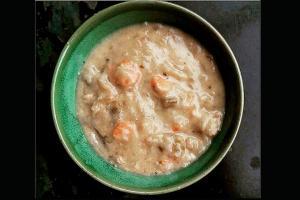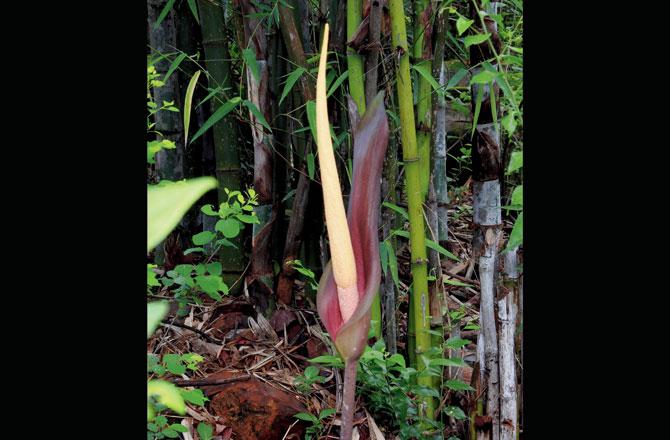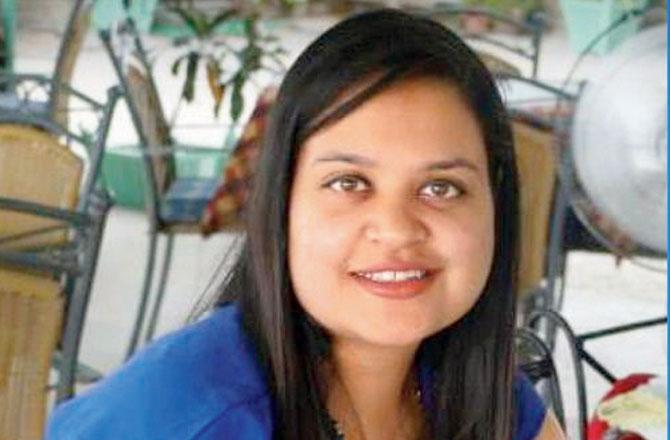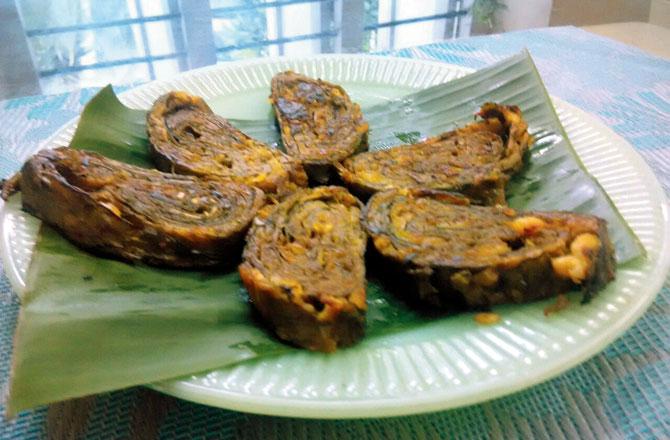A Pathare Prabhu chef shares vegetarian recipes seasonal to Maharashtra's monsoon

Along with the first showers in Mumbai, the raan-meva would arrive, ferried by Vasaiwallas or local vendors from Vasai," recollects Pathare Prabhu chef Sunetra Vijaykar, about her childhood days, adding, "Raan-meva literally translates to sweets from the forests. These vegetables and shrubs, usually only available during the rain, are mostly foraged." And so, they need to be treated before eating, or they can lead to allergies. "Grandmothers in Marathi households typically use tamarind or bilimb [a summer fruit] to do so," adds Vijaykar, who runs a pop-up service called Dine With Vijaykars in Mumbai and Gurugram.
ADVERTISEMENT
Chief among the wild produce is shevla, which is only available at the beginning of monsoon. "Shevla or dragon stalk yam is a long, leafy vegetable that's considered good for immunity. While most Maharashtrian communities make shevla chi bhaji, Pathare Prabhus make shevla che sambharye — a stew with coconut milk," she shares.

Shevla is found in the first few weeks of monsoon
Like the shevla, western Maharashtra's typical topography makes it fertile ground for other unique vegetables and shrubs in monsoon. "These include mayalu [Malabar nightshade], which is great for the digestive system; kantola or spiny gourd, which is consumed fried or stuffed with kheema; taakla, a leafy vegetable that's great for the skin; phodshi or safed mulshi, which is rich in carbs and good for immunity, and a variety of tubers like suran," she explains. "At our home, rains also meant crispy fried aluwadi," she reminisces, adding, "Aluwadi is a gift that Pathare Prabhus earned from their association with the Gujarat Sultanate in the 14th century. It is made with taro leaves, which are found in abundance now."
Shevla che sambharye
Ingredients
8 to 10 pairs of shevla
1 coconut's milk (in thick and thin consistency)
2 onions (chopped)
1 lemon-sized tamarind (soaked in water)
8 to 10 prawns (optional)
1 to 2 tbsp oil
1 tbsp besan
1 tbsp Pathare Prabhu sambar masala or any garam masala
½ tsp red chilli powder
¼ tsp hing
½ tsp sugar
Salt to taste

Method
Remove the outer red-green skin. Rub some oil on your palms when cleaning it. Clean the yellow dotted parts of the stem, which lead to itchiness. The fleshy, edible stamen has to be chopped into tiny pieces. Heat oil in a thick-bottomed vessel. Add the onion, hing and chopped shevla, and fry it. After it softens, add the masalas, salt and tamarind pulp and continue frying till the oil separates. Now, pour a cup of water and boil the shevla; this should take 20 minutes. Once done, cool it completely and grind it in a mixer. Some families don't grind it to enjoy the mushroom-like texture of shevla. Add besan to the thin coconut milk, and mix it well so that there are no lumps. Place the ground mixture on a vessel on heat. Slowly, add the coconut milk-besan mix. If you're using prawns, add them now. After three to four minutes, pour the thick coconut milk and the sugar to get a stew-like consistency. Let it cook for a few more minutes on low flame. It tastes best with steamed rice.
Aluwadi

Ingredients
6 brown and purple taro leaves
1 large lump of tamarind (soaked in water)
For the stuffing:
2 cups chana dal (ground)
2 tsp dry roasted jeera
1 inch ginger
Salt to taste
2 onions (chopped)
½ cup coriander
(chopped)
10 to 12 green chillies (chopped)
1 cup coconut (shredded)
1 tsp red chilli powder
½ tsp turmeric
2 tbsp ghee
Method
Wash the taro leaves and pat them dry with a kitchen towel. In a vessel, add all the ingredients for the stuffing (except the chana dal mixture) and crush them with your hand to release the juice of the onion and coriander. Now, add the chana dal mixture, ghee, half a cup of water and mix well. Take the largest taro leaf and flatten it with a rolling pin with the shiny side facing down. Smear the leaf with generous amounts of tamarind pulp. Take a lump of the dal paste and smear it on the leaf. You may add steamed shrimps or kheema, too. Repeat the process with another leaf. With the third leaf, don't add any more of the dal mixture. Hold the sides of the leaves inward and start rolling them into a cylindrical shape. Keep a steamer ready and steam the rolls for 15 to 20 minutes. Take a knife or fork and pierce to check if it comes out clean. If it does, then the rolls are steamed well. Let the rolls cool down completely. Cut one-centimetre-thick discs. Next, in a tawa, add some ghee/oil and shallow fry the discs.
Storage hack: The steamed rolls can be cooled and stored in the freezer for months.
Storage hack: Clean and sun-dry the shevla and store it in the freezer for months. You can also store it after frying.
Catch up on all the latest Mumbai news, crime news, current affairs, and a complete guide from food to things to do and events across Mumbai. Also download the new mid-day Android and iOS apps to get latest updates.
Mid-Day is now on Telegram. Click here to join our channel (@middayinfomedialtd) and stay updated with the latest news
 Subscribe today by clicking the link and stay updated with the latest news!" Click here!
Subscribe today by clicking the link and stay updated with the latest news!" Click here!






